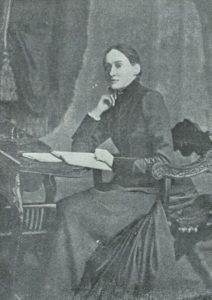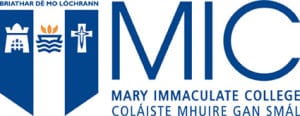George Egerton and the Fin de Siècle
Dr Whitney Standlee, University of Worcester

I remember precisely the moment I first discovered her. It was twelve years ago, I was sitting on a chair in a foyer waiting to meet with my prospective MA supervisor, and I was reading a story I had started the night before: a story I found promising in its opening pages and which grew ever more exciting as I read it. It was an 1890s work of short fiction, written by a woman who used a male pseudonym, and it concerned the experiences of a female narrator, a working woman, as she made her way from Norway to England by ship. Comprised primarily of a tale within a tale told to the narrator by a fellow traveller – a female academic (of all things!) – about the adopted daughter she has nicknamed ‘The White Elf’, the story was most intriguing to me because it included not only a challenging of gender roles but also an experimentation with literary form that made it seem well ahead of its time. I finished the story as I waited, and when called into the office, immediately announced that I would be doing my MA on the author of that short story, George Egerton. That was the first time I was faced with the question ‘who is George Egerton?’, but it was destined to be a query I would become intimately familiar with in the ensuing years.
I soon learned, however, that other, far more eminent commentators were not as impressed with Egerton’s work as I was. Although Holbrook Jackson, in his 1913 study The 1890s, had drawn attention to her literary innovations, he treated her primarily as a footnote to the era rather than a primary player in it. Terence de Vere White was far more critical of both her and her work in his A Leaf from the Yellow Book (1958) – for many their first introduction to Egerton’s life and letters, and not an encouraging one. Elaine Showalter, too, dismissed her as a ‘wasted talent’ even as she held Egerton up as an exemplar of early ‘feminist’ writers in A Literature of Their Own (1978).
Such prominent (de)valuations consistently caused me to question the validity of my own judgment and the legitimacy of the study I was undertaking. Yet I could not help but notice that there were growing numbers of academic researchers, the majority of them female, who were beginning to reassess Egerton’s legacy. These included Nicole Fluhr, Shanta Dutta, Iveta Jusová, Sally Ledger, Scott McCracken, Ann Heilmann and a notable Irish contingent that counted Gerardine Meaney, Heather Ingman and Tina O’Toole among its number. Especially important was the pioneering work on Egerton done by a woman named Margaret Stetz, whose PhD thesis, completed in 1982 at Harvard, was then and remains the seminal study of Egerton’s life.
Fast forward twelve years to 8 April 2017 at Loughborough University, where the second day of a two-day conference on ‘George Egerton and the Fin de Siècle’ is underway. It opens with a keynote address by Margaret Stetz, now Mae & Robert Carter Professor of Women’s Studies at the University of Delaware. Regrettably, I am only able to attend the conference’s second day, but by the time I arrive the atmosphere is electric. Dozens of presenters and delegates are in the audience, and Stetz’s tales of coming to Egerton, and fighting against the damaging legacy of A Leaf from the Yellow Book, cement her status as a pathmaker in what is now known as ‘Egerton studies’. Throughout the two days of the conference, paper after paper focuses on the ways in which Egerton’s work thwarts both gendered and literary conventions and challenges established boundaries. Those boundaries include both gendered and national ones, and perhaps the most fascinating aspect of the conference is the diversity of presenters and their presentations. There are delegates from France, the USA, Switzerland, Norway and Turkey as well as the UK and Ireland in attendance. Subjects range from Egerton’s translations of the works of the Swedish author Ola Hansson and Norwegian Knut Hamsun (by Peter Sjølyst-Jackson, Stefano-Maria Evangelista and Naomi Hetherington) to her portrayals of sexuality (Rosie Miles, Anthony Patterson and Alexandra Gray) and urban identities (Sravya Raju, Jennifer Nicol and Anne-Marie Beller).
Although many scholars understandably continue to focus on Keynotes and Discords (these are the first and most famous of her volumes of short stories, and also the most readily accessible due to the fact that they are available in a modern Virago edition), there are a number of presenters who choose to focus on her more obscure output (namely, her short story collections Symphonies and Fantasias, and her sole novel, The Wheel of God). The Irish context of her work is also the subject of discussion in a fascinating paper by Eleanor Fitzsimons.
In a conference filled with excellent work not only by established academics but also by highly promising young scholars, the highlights are undoubtedly Stetz’s keynote and the roundtable discussion between Stetz, Ann Heilmann and Rosie Miles that closes the conference. Over the conference’s final hour, these three eminent and engaging women make it clear that, 124 years after her first work was published, George Egerton is still dividing opinion and encouraging debate on women’s issues and other concerns that remain not only important but relevant in both a specifically Irish and international context. Their intense personal connection to Egerton and their personal paths to finding Egerton’s work remind many of the delegates, including me, of how we ourselves first came to discover this controversial writer.
My own final discussion that weekend was with Sínead Mooney, who needs no introduction to members of the Irish Women’s Writing (1880-1910) Network. She asked me how I myself had come to discover Egerton. It was, as I’ve stated, through a volume of short stories – an anthology entitled That Kind of Woman edited by Bronte Adams and Trudi Tate – that I first encountered Egerton’s ‘The Spell of the White Elf’. But, in truth, it was James Joyce that led me there, because my purpose in reading a collection of short stories by (proto-)modernist women writers was an attempt to find at least one Irish precursor to the literary experimentation that had so blown me away when I first read Dubliners. I suppose I should have found her on her own terms, in her own space. But in reality, I backed my way into her through a male writer and his canonical work. I have a feeling that this is not at all an unusual experience.
It is to be hoped that this will not be the last conference organised on Egerton’s work, and that in the future studies will branch out to include (and embrace) her more difficult to access literary output, such as her final collection of short stories, Flies in Amber, and her experimental epistolary volume, Rosa Amorosa, which she herself considered her finest work. The ‘George Egerton and the Fin de Siècle’ conference did much to invigorate Egerton studies, and demonstrated that, even as academic work on her proliferates, there is still much more to be discovered and written about George Egerton and her texts.
Dr Whitney Standlee, University of Worcester
If you have any suggestions for the blog or would like to submit a post email Dr Deirdre Flynn



